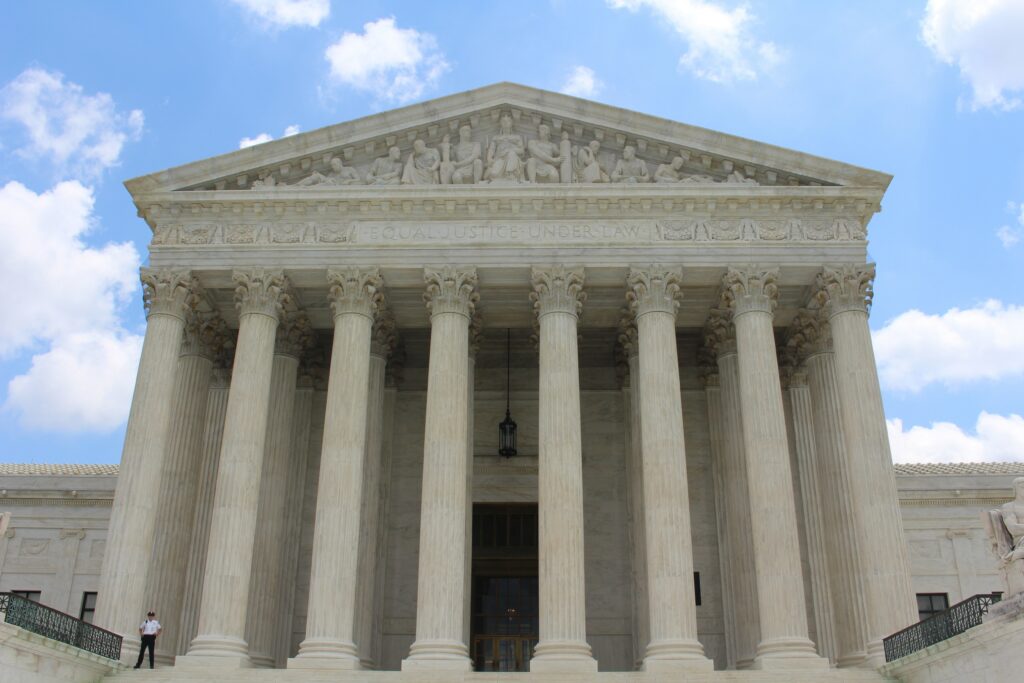
Yesterday, the Supreme Court released two important decisions in Warhol Foundation v. Goldsmith and Gonzalez v. Google—cases that Authors Alliance has been deeply invested in, submitting amicus briefs to the Court in both cases.
Warhol Foundation v. Goldsmith and Transformativeness
First, the Court issued its long-awaited opinion in Warhol Foundation v. Goldsmith, a case Authors Alliance has been following for years, and for which we submitted an amicus brief last summer. The case concerned a series of screen prints of the late musical artist Prince created by Andy Warhol, and asked whether the creation and licensing of one of the images, an orange screen print inspired by Goldsmith’s black and white photograph (which the Court calls “Orange Prince”), constituted fair use. After the Southern District of New York found for the Warhol Foundation on fair use grounds, the Second Circuit overturned the ruling, finding that the Warhol Foundation’s use constituted infringement. The sole question before the Supreme Court was whether the first factor in fair use analysis, the purpose and character of the use, favored a finding of fair use.
To our disappointment, the Supreme Court’s majority agreed with the holding of the district court, finding that the purpose and character of Warhol’s use favored Goldsmith, such that it did not support a finding of fair use. This being said, the decision focused narrowly on the Warhol Foundation’s “commercial licensing of Orange Prince to Condé Nast,” expressing “no opinion as to the creation, display, or sale of any of the original Prince Series works.” Because the Court cabins its opinion, focusing specifically on the licensing of Orange Prince to Condé Nast rather than the creation of the entire Prince series, the decision is less likely to have a deleterious effect on the fair use doctrine generally than a broader decision would have.
Writing for the majority, Justice Sotomayor argued that Goldsmith’s photograph and the Prince screen print in question shared the same purpose, “portraits of Prince used to depict Prince in magazine stories about Prince.” Moreover, the Court found the use to be commercial, given that the screen print was licensed to Condé Nast. Justice Sotomayor explained that “if an original work and secondary use share the same or highly similar purposes, and the secondary use is commercial, the first fair use factor is likely to weigh against fair use, absent some other justification for copying.” Justice Sotomayor found that the two works shared the same commercial purpose, and therefore concluded that factor one favored Goldsmith.
Justice Kagan, joined by Chief Justice Roberts, issued a strongly worded dissenting opinion. The dissent admonished the majority for its departure from Campbell’s “new meaning or message test,” an inquiry that Authors Alliance advocated for in our amicus brief. Justice Kagan further criticized the majority’s shifting focus towards commerciality, arguing that the fact that the use was a licensing transaction should not be given so much importance in the analysis. While Authors Alliance agrees with these points, we are less sure that the majority’s decision goes so far as to “constrain creative expression” or “threaten[] the creative process. And while it’s uncertain what effect this case will have on the fair use doctrine more generally, one important takeaway is that the question of whether the use in question is commercial in nature—a consideration under the first factor—has been elevated to one of greater importance.
While we thought this case offered a good opportunity for the Court to affirm a more nuanced approach to transformative use, we much prefer the Supreme Court’s approach to the Second Circuit’s decision, and applaud the Court on confining its ruling to the narrow question at issue. The holding does not, in our view, radically alter the doctrine of fair use or disrupt a bulk of established case law. Moreover, some aspects of arguments we made in our brief—such as the notion that transformativeness is a matter of degree, not a binary—are present in the Court’s decision. This is a good thing, in our view, as it will allow for more nuanced consideration of a use’s character and purpose, and stands in contrast to the Second Circuit’s all or nothing view of transformativeness.
Gonzalez v. Google and the Missing Section 230
Also yesterday, the Court released its opinion in Gonzalez v. Google, a case that generated much attention because of its potential threat to Section 230, and another case in which Authors Alliance submitted an amicus brief. The case asked whether Google could be held liable under an anti-terrorism statute for harm caused by ISIS recruitment videos that YouTube’s algorithm recommended. In its per curiam decision (a unanimous one without a named Justice as author), the Court stated that Gonzalez’s complaint had failed to state a viable claim under the relevant anti-terrorism statute. Therefore, it did not reach the question of the applicability of Section 230 to the recommendations at issue. In other words, a case that generated tremendous concern about the Court disturbing Section 230 and harming internet creators, communities, and services that relied on it ended up saying nothing at all about the statute.
Discover more from Authors Alliance
Subscribe to get the latest posts sent to your email.
